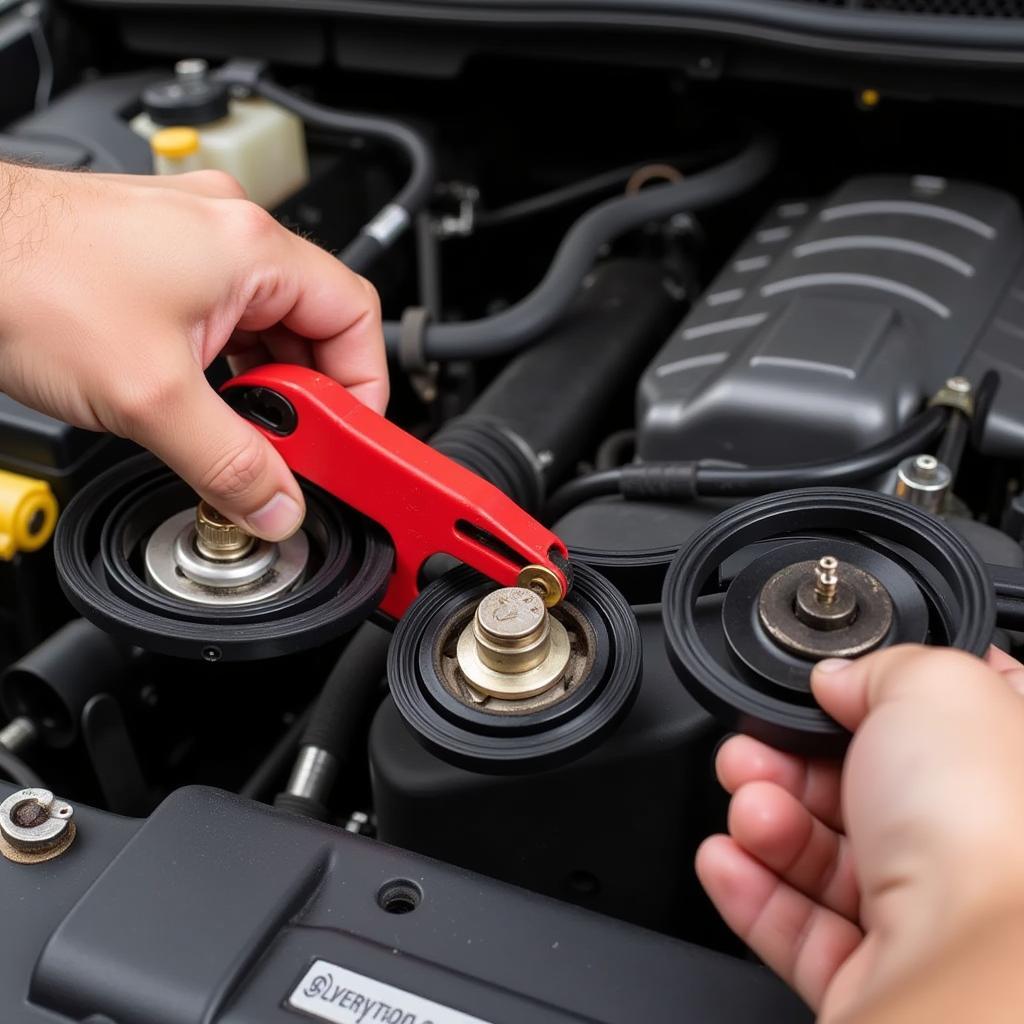A bad pulley can wreak havoc on your car’s engine, leading to anything from annoying noises to catastrophic engine failure. Understanding how to diagnose and fix this problem can save you time, money, and a whole lot of stress. This guide will walk you through the process, equipping you with the knowledge to tackle a bad pulley head-on.
Recognizing the Signs of a Bad Pulley
Before you start tinkering under the hood, it’s crucial to be certain that the pulley is indeed the culprit. Here are some telltale signs that scream “bad pulley”:
- Squealing or Chirping Noises: One of the most common symptoms is a high-pitched squealing or chirping coming from the engine bay, particularly upon startup or acceleration. This noise usually originates from a worn-out bearing within the pulley.
- Visible Wear and Tear: Inspect your pulleys closely. Look for cracks, chips, or wobbling. If you notice any of these signs, it’s a strong indication that the pulley needs replacement.
- Belt Slipping or Breaking: A bad pulley can cause the serpentine belt to slip or even break. This can lead to a loss of power steering, alternator failure, and overheating.
- Overheating Engine: A seized pulley can put extra strain on the engine, leading to overheating.
Types of Pulleys in Your Car
To effectively troubleshoot pulley issues, it’s helpful to understand the different types of pulleys found in your car:
- Crankshaft Pulley: This pulley is mounted on the crankshaft and is responsible for driving the serpentine belt.
- Alternator Pulley: This pulley drives the alternator, which generates electricity for the car’s electrical system.
- Water Pump Pulley: As its name suggests, this pulley drives the water pump, which circulates coolant through the engine to regulate temperature.
- Power Steering Pump Pulley: This pulley drives the power steering pump, providing hydraulic assistance for easier steering.
- Idler Pulley: The idler pulley doesn’t drive any specific component but serves to guide and provide tension to the serpentine belt.
- Tensioner Pulley: Similar to the idler pulley, the tensioner pulley provides tension to the serpentine belt and also acts as a shock absorber, preventing belt vibrations.
Tools You’ll Need for the Job
Gather the following tools before beginning any repair work:
- Socket set
- Wrench set
- Torque wrench
- Serpentine belt tool
- New pulley (of the correct type)
- Protective gloves and eyewear
How to Fix a Bad Pulley
Step 1: Identify the Faulty Pulley
Locate the source of the noise or the pulley showing visible damage. Use a mechanic’s stethoscope if necessary to pinpoint the exact location.
Step 2: Relieve the Belt Tension
Using the serpentine belt tool, relieve the tension on the belt by moving the tensioner pulley. Once the tension is released, carefully remove the serpentine belt from the faulty pulley.
 Removing the Serpentine Belt
Removing the Serpentine Belt
Step 3: Remove the Bad Pulley
Use a socket or wrench to hold the pulley in place while loosening the retaining bolt. Once the bolt is removed, carefully pull the pulley off the mounting shaft.
Step 4: Install the New Pulley
Align the new pulley with the mounting shaft and slide it into place. Secure the pulley with the retaining bolt, but don’t tighten it completely yet.
Step 5: Reinstall the Serpentine Belt
Route the serpentine belt back onto all the pulleys, including the new one. Use the serpentine belt tool to apply tension to the belt and ensure it’s properly seated on all the pulleys.
Step 6: Torque the Pulley Bolt
Using a torque wrench, tighten the pulley bolt to the manufacturer’s specified torque. This is crucial to prevent the pulley from coming loose.
Step 7: Double-Check Your Work
Start the engine and listen for any unusual noises. If everything sounds good, visually inspect the pulleys and belt while the engine is running to ensure proper alignment and tension.
Expert Insights
“Many people underestimate the importance of regular pulley inspections,” says John Smith, a seasoned automotive engineer with over 20 years of experience. “A simple inspection during your regular maintenance can catch a worn-out pulley early on, preventing costly repairs down the line.”
Conclusion
Addressing a bad pulley promptly is essential for maintaining your car’s performance and preventing further damage. By following this comprehensive guide, you can confidently diagnose and fix a bad pulley, ensuring a smooth and safe driving experience.
Need further assistance? Don’t hesitate to contact the experts at AutoTipPro for professional guidance and support. You can reach us at +1 (641) 206-8880 or visit our office at 500 N St Mary’s St, San Antonio, TX 78205, United States.
FAQ
1. Can I drive with a bad pulley?
It’s highly discouraged to drive with a bad pulley. Doing so can lead to further damage to your engine and other components.
2. How much does it cost to fix a bad pulley?
The cost can vary depending on the make and model of your car and labor costs in your area. However, it’s a relatively inexpensive repair compared to other engine issues.
3. How often should I replace my pulleys?
While there’s no set replacement interval, it’s recommended to inspect your pulleys every 60,000 miles or sooner if you hear unusual noises.
4. Can I replace a pulley myself?
With the right tools and mechanical aptitude, it’s possible to replace a pulley yourself. However, if you’re unsure, it’s always best to consult a qualified mechanic.
5. What causes a pulley to go bad?
The most common cause of pulley failure is wear and tear on the bearings over time. Other factors include exposure to extreme temperatures, contamination, and improper installation.




Leave a Reply